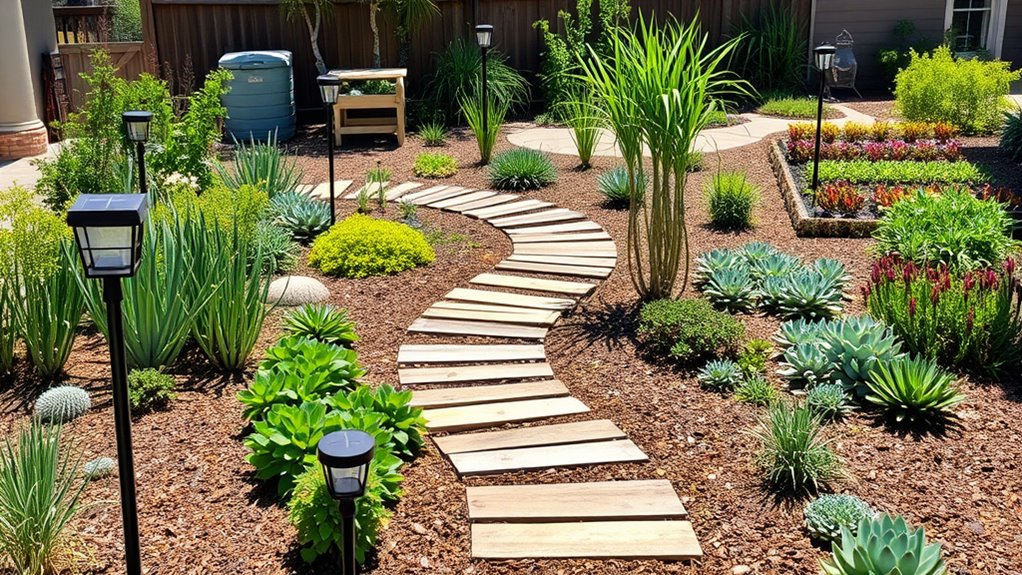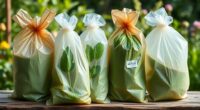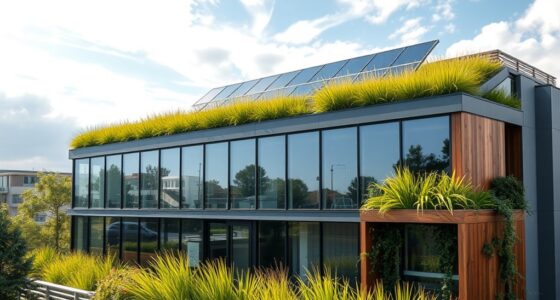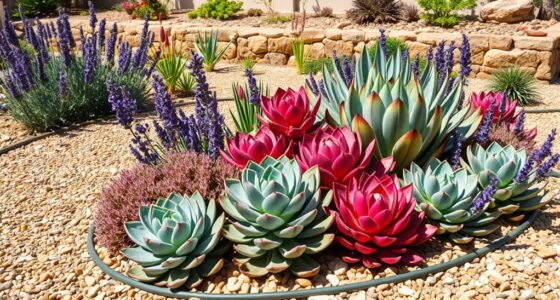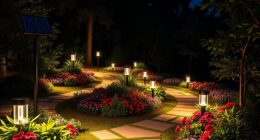To create an eco-friendly yard, focus on sustainable landscape design by using native plants that thrive with less water and fewer chemicals. Employ water conservation methods like drip irrigation, rain gardens, and mulching to reduce water use. Plan your site to maximize shade and encourage water infiltration with permeable pavements. Incorporate drought-tolerant plants and strategic placement to boost resilience and biodiversity. Explore these strategies further to transform your yard into an environmentally responsible oasis.
Key Takeaways
- Incorporate native plants to reduce water, fertilizers, and pesticide needs while supporting local ecosystems.
- Use water-saving techniques like drip irrigation, rain gardens, and mulch to conserve water efficiently.
- Plan landscapes to maximize shade, reduce evaporation, and promote water infiltration with permeable surfaces.
- Design eco-friendly features such as rain gardens and native plantings that enhance resilience and sustainability.
- Achieve cost savings and environmental benefits through reduced resource use, increased biodiversity, and low-maintenance landscaping.
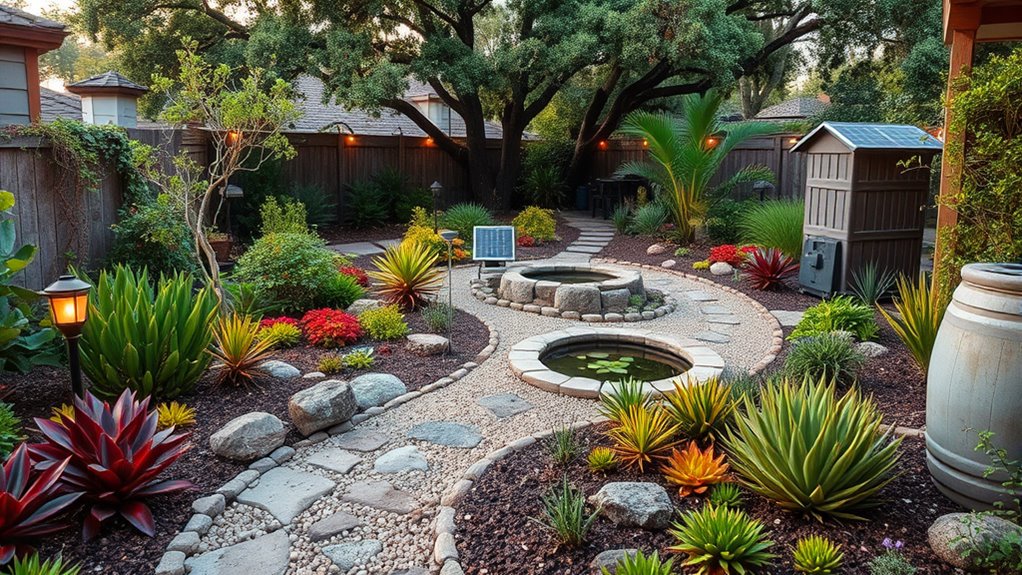
Have you ever wondered how to create a landscape that’s both beautiful and environmentally responsible? The key lies in understanding sustainable landscape design, which emphasizes eco-friendly practices that benefit your yard and the planet. One of the most effective ways to achieve this is by incorporating native plants into your garden. Native plants are adapted to your local climate and soil, so they require less water, fertilizers, and pesticides. This means you can enjoy vibrant, thriving landscapes with minimal maintenance while also supporting local ecosystems. By choosing native plants, you’re creating a resilient landscape that naturally resists pests and diseases, reducing the need for chemical interventions that can harm the environment.
Water conservation is another essential element of sustainable landscape design. Traditional lawns and gardens often demand excessive watering, especially during dry seasons, which strains local water supplies and increases your utility bills. To combat this, you can implement water-saving techniques such as drip irrigation systems and rain sensors that deliver water directly to the roots, reducing waste. Additionally, grouping plants with similar water needs together allows you to tailor watering schedules efficiently. Mulching around plants helps retain soil moisture, further decreasing the amount of water your landscape requires. When selecting plants, opt for drought-tolerant varieties that can thrive with less water, ensuring your garden remains lush without over-relying on supplemental irrigation.
Designing with water conservation in mind also involves thoughtful site planning. For instance, orienting your landscape to maximize shade in hot areas can lower evaporation rates and keep your plants healthier. Creating rain gardens or installing permeable pavements helps manage runoff and encourages groundwater recharge, reducing the burden on stormwater systems. Incorporating native grasses and ground covers can also effectively suppress weeds and stabilize soil while needing less watering and fertilization. Using portable irrigation equipment can make watering more efficient and easier to manage, especially in larger or more complex landscapes. These strategies not only conserve water but also contribute to a more sustainable, low-maintenance landscape that remains beautiful throughout the year. Additionally, selecting plants based on their adaptation to local conditions ensures a more resilient and eco-friendly garden design.
Frequently Asked Questions
How Can I Incorporate Native Plants Into My Landscape?
To incorporate native plants into your landscape, start with native plant selection that suits your local climate and soil. Focus on regional plant adaptation to guarantee they thrive naturally, reducing water and maintenance needs. You can create a vibrant, eco-friendly yard by choosing indigenous species that support local wildlife. Plan your garden to highlight these plants, blending beauty with sustainability, and you’ll enjoy a thriving, eco-conscious landscape.
What Sustainable Materials Are Best for Garden Paths?
Perfect pathways promote planet-friendly practices. You should consider permeable pavements, which allow water to seep through, reducing runoff, and recycled aggregates, repurposing waste into wonderful walkways. These sustainable materials not only save resources but also support eco-conscious landscapes. By choosing these environmentally friendly options, you create charming, functional garden paths that protect the planet while enhancing your outdoor space.
How Do I Reduce Water Usage in My Yard?
To reduce water usage in your yard, start by installing rainwater harvesting systems to collect and reuse rainwater. Choose drought-tolerant plants that require less water and thrive in your climate. Mulch around plants to retain moisture, and water early in the morning or late in the evening to minimize evaporation. These steps help conserve water while maintaining a healthy, vibrant yard.
What Are Eco-Friendly Pest Management Options?
Did you know that over 90% of homeowners prefer natural pest control methods? You can manage pests eco-friendly by using composting techniques to boost soil health, making plants more resistant. Additionally, apply organic fertilizers to strengthen your plants naturally, reducing the need for chemical pesticides. These methods protect beneficial insects and the environment, creating a balanced yard where pests are kept in check without harmful chemicals.
How Can I Attract Pollinators Naturally?
You can attract pollinators naturally by planting wildflowers, which provide essential nectar and habitat. Incorporate bee-friendly features like native plants, undisturbed soil, and water sources to support bees, butterflies, and other pollinators. Avoid pesticides, and create diverse flowering areas that bloom throughout the season. This approach encourages healthy pollinator populations, benefiting your garden’s growth and supporting local ecosystems.
Conclusion
Think of your yard as a living canvas, where every eco-friendly choice you make adds vibrant, sustainable strokes. By designing with nature in mind, you become the artist shaping a healthier, more resilient landscape. Your efforts create a lush mosaic that supports local wildlife and conserves resources. Remember, each small change is like planting a seed of positive impact—growing into a beautiful, enduring masterpiece that benefits both your home and the planet.
